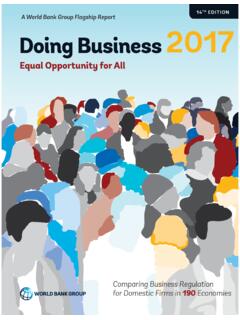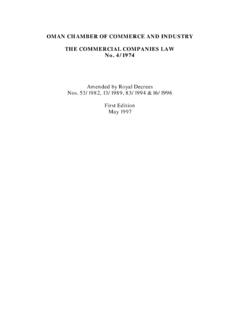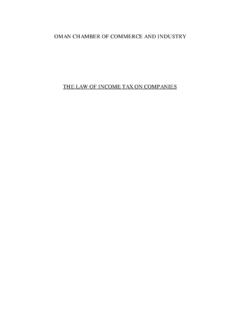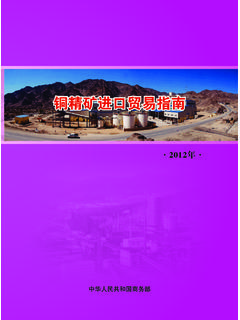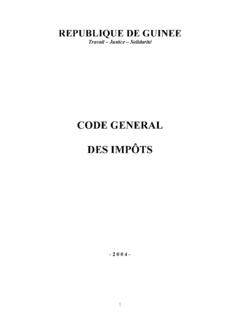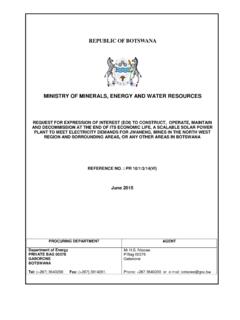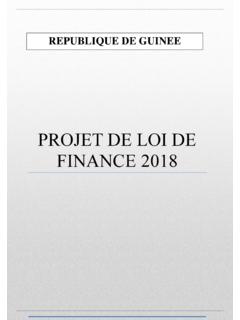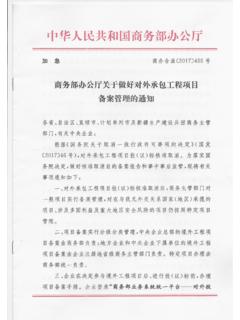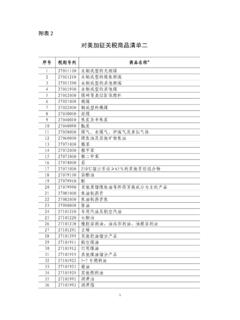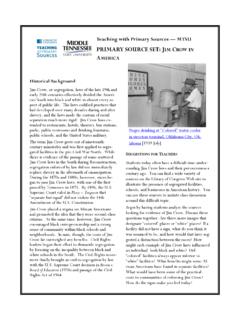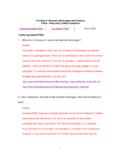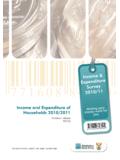Transcription of ETHIOPIA - MOFCOM
1 Ethiopian Investment Commission (EIC). ETHIOPIA : A Preferred Location for Foreign Direct Investment in Africa 2015. 1. TABLE OF CONTENTS. I. INTRODIUCING ETHIOPIA 1. II. THE OPERATING ENVIROMENT 5. Political Environment Economic Environment Trade and Investment Infrastructure Financial Services Taxation Human Resource Market III. AREAS OF OPPORTUNITY. Agriculture Manufacturing Tourism Mining Hydropower Social Services IV. THE LEGAL FRAMEWORK. Legal and Judicial System Institutional Framework Investment Incentives Export Incentives Remittance of Capital V.
2 APPENDICES. I. Restrictions II. Investment Areas Open for Foreign Investors III. Areas of Investment eligible for exemption of customs duty IV. Areas of Investment eligible for exemption of income tax V. Bilateral investment Treaties VI. Tips for foreign investors VII. Client charter of EI. VIII. Source of further information 2. iiIi Official name Federal Democratic Republic of ETHIOPIA (FDRE). Political system Federal with multi-party system Head of state President: Dr. Mulatu Teshome Head of government Prime Minister: Hailemariam Dessalegn Capital city Addis Ababa; which is also the seat of the African Union (AU) and United Nations Economic Commission for Africa (ECA), among others.
3 Location ETHIOPIA is located at the northeastern part of Africa extending 30 to 150 north of the equator and 330 to 480 east of the Greenwich Meridian. ETHIOPIA enjoys a unique location at crossroads between Africa, the Middle East and Asia. Area million square kilometers. Arable land 513,000 square kilometers (45%). Irrigated land 34,200 square kilometers (3%). Climate There are two major seasons encompassing dry and wet seasons. The dry season prevails from October through May. The wet season runs from June to September.
4 Much of ETHIOPIA has a surprisingly temperate climate by African standards, because of its elevation. Topography ETHIOPIA has an elevated central plateau varying in height from 2,000. to 3,000 meters above sea level. In the North and centre of the country, there are some 25 mountains whose peaks reach over 4,000. meters. The most famous Ethiopian river is the Blue Nile or Abbay, which 3. flows a distance of 1,450 kilometers from its source to join the White Nile at Khartoum. Population Over 90 million Population density per sq.
5 Km GDP per capita US$ 632 (2013/14). Religion Major religions in the country are Christianity and Islam. But there are a number of traditional religions as well. One prominent feature of ETHIOPIA is religious tolerance that exists among different religious groups. Language ETHIOPIA is a multi-ethnic state with a great variety of languages spoken; out of which 83 have over 200 dialects. Amharic is the working language of the Federal Government. Oromiffa, Somali and Tigrigna are other major languages widely spoken in the country.
6 English is a medium of instruction in junior and secondary schools, and higher educational institutions; and widely spoken, particularly, in business transactions. Calendar ETHIOPIA uses the Julian calendar, which divides the year into 12. months of 30 days each. The remaining five or six days in a leap year, constitute the short 13th month known as "Pagume". The calendar is seven years behind the Western or Gregorian Calendar, with the Ethiopian New Year falling on 11th of September. Working hours ETHIOPIA is in the GMT+3 time zones.
7 The government office hours are 8:30 am - 12:30 pm and 1:30 pm - 5:30 pm from Monday through Thursday; and 8:30 am to 11:30 and 1:30 pm to 5:30 pm on Fridays. Administrative division. There are nine regional states, and two city adminstratioins, including Addis Ababa in the country. Main cities/ towns Addis Ababa Harar Adama Hawassa Bahir Dar Jimma Dessie Mekele Gondar Dire Dawa Currency The currency of ETHIOPIA is based on the decimal system. The units of currency are the Birr and cents. The Birr is divided into 100 cents.
8 4. ||. 1. Political Environment ETHIOPIA is considered as one of the most stable countries in Africa. The Constitution of the country, adopted in 1995, provides for a multi-party political system. Elections are held by universal adult suffrage every five years The FDRE has a parliamentarian form of government with a bicameral parliament, which comprises the House of the Peoples' Representatives (HPR). and the House of the Federation (HoF). The House of the Peoples'. Representatives is the highest authority of the Federal Government.
9 Power of government is assumed by the political party or a coalition of political parties that constitutes a majority in the House of the Peoples' Representatives (HPR);. Executive power is vested in the Prime Minister, elected from among the members of the HPR for a five-year term;. ETHIOPIA may well be considered as a country with the lowest levels of crime and corruption among least developed countries. 2. Economic Environment The Ethiopian government has formulated the five year Growth and Transformation Plan (GTP) to carry forward the important strategic directions in maintaining a fast growing economy in all sectors.
10 Accordingly, ETHIOPIA 's economy is projected to grow at an average rate of percent annually. Enormous efforts have been made in major key sectors to achieve the Millennium Development Goals (MDGs). As a result, the Ethiopian economy witnessed sustainable 5. double digit and broad-based growth. In 2013/14, real GDP grew by percent, moderately higher than the previous year. In the first three years of Growth and Transformation Plan (GTP) implementation, the GDP had grown on average by about percent per annum.
